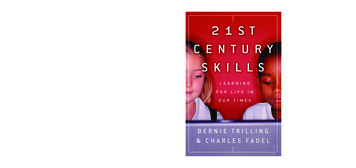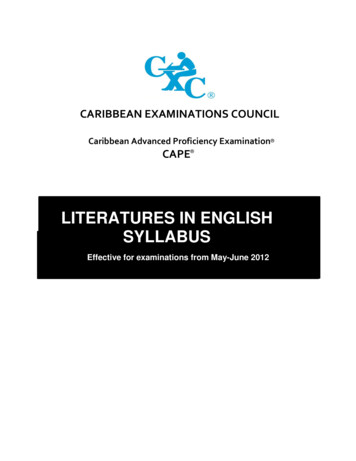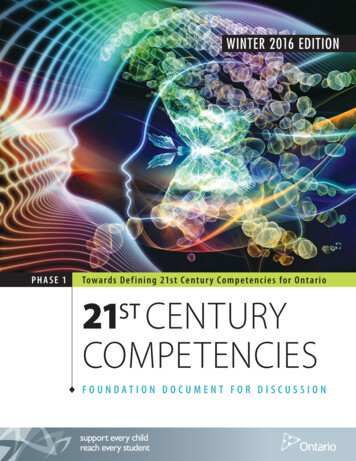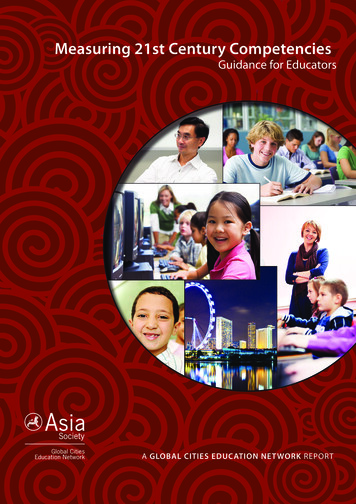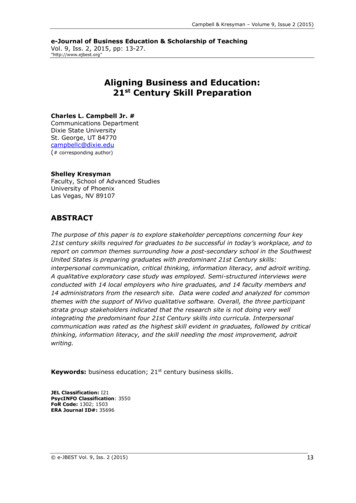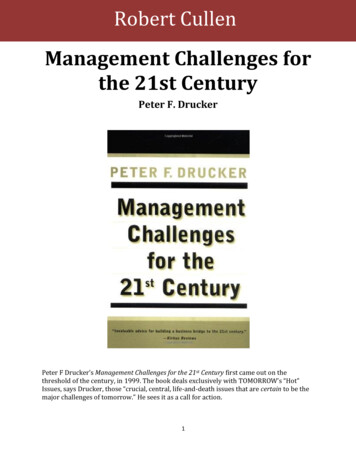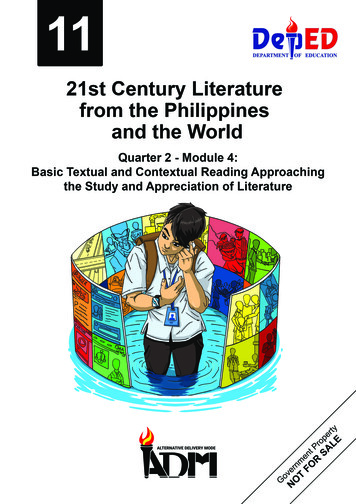
Transcription
21st Century Literatures from the Philippines and the World – Grade 11Alternative Delivery ModeModule 4: Basic Textual and Contextual Reading Approach in theStudy and Appreciation of LiteratureFirst Edition, 2019Republic Act 8293, section 176 states that: No copyright shall subsist in anywork of the Government of the Philippines. However, prior approval of thegovernment agency or office wherein the work is created shall be necessary forexploitation of such work for profit. Such agency or office may, among other things,impose as a condition the payment of royalties.Borrowed materials (i.e., stories, songs, poems, pictures, photos, brandnames, trademarks, etc.) included in this book are owned by their respectivecopyright holders. Every effort has been exerted to locate and seek permission touse these materials from their respective copyright owners. The publisher andauthors do not represent nor claim ownership over them.Published by the Department of EducationSecretary:LeonorDevelopmentM. Briones Team of the rs: MarjorieSecretary:Juvy Turno – ImportanteNoemi C. Montecillo – AbellanosaReviewers:Lepelyn S. ValdezDevelopmentTeam of the ModuleJose B. Cruz, Jr.Marie Joy S. AridaAuthors:Marjorie Camino-TagacayIllustrator:Jay Michael A. CalipusanJuvy Turno – ImportanteNoemiC. Montecillo – AbellanosaManagement Team:Editors:Chairperson:Dr. Arturo B. Bayocot, CESO IIIRegionalDirectorReviewers:Lepelyn S. ValdezCo-Chairpersons:Dr.VictorG. De Gracia Jr., CESO VJose B. Cruz, Jr.Asst.RegionalDirectorMarie Joy S. AridaMala Epra B. MagnaongCES, CLMDIllustrator:Members:Dr. Bienvenido U. Tagolimot, Jr.Regional ADM CoordinatorLayout Artist:Dr. Angelina B. BuaronEPS, EnglishManagement Team:Printed in the Philippines by: Department of Education – Regional Office 10Zoneby1,Upper Balulang Cagayan de Oro City 9000PrintedOfficein theAddress:PhilippinesTelefax: (088) 880-7071, (088) 880-7072Department of Education – Bureau of Learning Resources (DepEd-BLR)E-mail Address: region10@deped.gov.phOffice Address:Telefax:E-mail Address:Zone 1, Upper Balulang Cagayan de Oro City 9000(088) 880-7071, (088) 880-7072region10@deped.gov.ph2
1111/1/121st Century ROMand the WorldTHE PHILIPPINES ANDTHE WORLDMODULE 4QUARTER2 - MODULEBASIC TEXTUALAND CONTEXTUALREADING4APPROACH INTHE STUDY AND APPRECIATION OF LITERATUREBASIC TEXTUAL AND CONTEXTUALREADING APPROACH IN THESTUDY AND APPRECIATIONOF LITERATUREThis instructional material was collaboratively developed and reviewedby educators from public and private schools, colleges, and/or universities.We encourage teachers and other education stakeholders to email theirfeedback, comments, and recommendations to the Department of Educationat action@deped.gov.ph.Weofvalueyour feedbackandofrecommendations.DepartmentEducation Republicthe PhilippinesDepartment of Education Republic of the PhilippinesDepartment of Education Republic of the Philippines31
Table of ContentsCover PageCopyright PageModule TitleWriters’ ProfileTable of ContentsWhat I Need to KnowWhat Should I ExpectThings to Remember To Get Through12345677CONTENTSLesson 1: Literary Genres, Elements, and StructuresWhat I KnowWhat I Need to KnowWhat I KnowWhat’s NewWhat’s MoreAssessmentLesson 2: Figures of Speech and other Literary TechniquesWhat I Need to KnowWhat I KnowWhat’s NewAssessmentWhat’s NewLesson 3: Biographical, Linguistic, and Socio - Cultural ContextsWhat I Need to KnowWhat I KnowWhat’s NewAssessmentLesson 4: Relationship Between Text and ContextWhat Should I ExpectWhat is itWhat’s NewLesson 5: Literary Meaning and StrategiesWhat I knowWhat Should I ExpectWhat is itWhat’s NewAssessment48Lesson 6: Application – ICT AdaptationWhat Should I ExpectWhat I can doRubrics for Self- and/or Peer Assessment of the CreativeAdaptation of Literary 383939425151
MODULE 4BASIC TEXTUAL ANDCONTEXTUAL READINGAPPROACH IN THE STUDY ANDAPPRECIATIONWHAT I NEED TOKNOWThis module helps the learner to understand and appreciate the literary textsin various genres across national literature and cultures. Because a multiculturalframework celebrates diversity, this module includes literary works from differentcountries reflecting the ethnicity, habits, and customs of various groups throughoutthe world. It also incorporates learning activities to help students get a moremeaningful encounter with literature. Moreover, the literary pieces are enriched withactivities which engage students in thought and writing using learning strategies toenhance their understanding, appreciation of the literary work, and multimedia andICT skills.6
WHAT SHOULD I EXPECTAt the end of the module, you are expected to:1. creatively interpret the short story through a short film adaptation;2. outline a short story;3. critique the adaptation using self- and peer-assessment based onrationalized criteria;4. plan and produce an adaptation of a short story or any type of literatureusing multimedia and ICT skills;5. initiate responsibility and cooperation in working on a creative adaptation;and observe oneness and concern for others.THINGS TO REMEMBER TOGET THROUGH6.7.8.After going through this module, the learners should1. produce critical paper that analyzes literary texts in relation tothe context of the reader and the writer or a critical paper thatinterprets literary texts using any of the critical approaches; and2. produce an adaptation of a text into other creative forms usingmultimedia.GOOD LUCK AS YOU BEGIN THIS MODULE!7
MODULE 4 – LESSON 1What I KnowBefore you start studying this module, may I know if you know the song“Blowin' In The Wind” by Bod Dylan? This song was released in 1963 as the firstsingle of his second studio album 'The Freewheelin' Bob Dylan'. The song speaksabout humanity, war, and peace and other ambiguous questions that people refuseto answer. Bob Dylan claims that the answers are already there.“Blowin' in the Wind”by: Bob DylanHow many roads must a man walk downBefore you call him a man?How many seas must a white dove sailBefore she sleeps in the sand?Yes, and how many times must the cannon balls flyBefore they're forever banned?The answer, my friend, is blowin' in the windThe answer is blowin' in the wind.Yes, and how many years can a mountain existBefore it is washed to the sea?Yes, and how many years can some people existBefore they're allowed to be free?Yes, and how many times can a man turn his headAnd pretend that he just doesn't see?The answer, my friend, is blowin' in the windThe answer is blowin' in the wind.Yes, and how many times must a man look upBefore he can see the sky?Yes, and how many ears must one man haveBefore he can hear people cry?Yes, and how many deaths will it take 'til he knowsThat too many people have died?The answer, my friend, is blowin' in the windThe answer is blowin' in the wind.8
After singing the song, analyze the song and answer the following questionsin your notebook.1. What is the poetic genre of this song?2. What figure of speech is used in the song? Give at least 3 lines to supportyour answer.3. What do the following words symbolize?a. roadsb. dovec. skyd. earse. deaths4. What is the theme and meaning of this song?5. Can you give at least three (3) quests of Bob Dylan as expressed in the song?9
LESSON 1LITERARY GENRES, ELEMENTS,AND STRUCTURESLearning Competencies: Infer literary meaning from literal language based onusage. EN12LitIId-26.What I Need to KnowObjectives: At the end of the lesson, you will be able to:1. analyze selected literary works by writers;2. identify the context of the literary text; and3. relate the context of a literary text to its meaning.What I KnowInstructions: Identify the correct literal meaning of the following words, write theletter of the correct answer.1. Lovea. intense feeling of affectionb. strong feeling of annoyancec. lack of sleepd. no remorse10
2. Boredoma. wearyb. hungryc. carryd. showy3. Glada. unwillingb. reluctantc. delightedd. dismayed4. Surmounta. beatenb. dominated someonec. leap overd. overcome a difficulty5. Implieda. suggested but not heardb. suggested but not directly expressedc. suggested but directly expressedd. suggested but get lostBefore analyzing a literary piece below, answer the following questions in yournotebook.1.What is the literal meaning of the word “itik?2.What ideas are implied by the word “Itik” in the text?“Gai Kog Itik, Parts”Jayson E. ParbaParts, daghan daw kag itiksa imong tugkaran?Tagai ko,Kanang nindot og lawas, ha?Kanang kimbot ug sampot.Ayaw nang sombra katambokBasin dali ra kayo hangosonUg usa pa, di ko ana,Kusog man gud na mukaon.Ayaw na pod nang niwang,Basin dali ra kayo kapoyon.Ug usa pa, di ko ana,Way lami kaunon ang bukogon.Kanang sakto lang ug lawasPara maigo sa akong kalha.Akong adobohon. Sa kalipayAko iyang busogon.11
What’s NewActivity 1Instructions: Reread the text. What inference can be made about the text. Copy thetable below and write the answers.Literal LanguageEx.ItikMeaningLiterary MeaningA species of duck thatproduces eggs madegirlinto balot.adobobusogkalhaWhat’s MoreInstructions: Write a five sentence paragraph on the question below.What is your ideal girl (if you are a boy) (or ideal boy if you are a girl)?( see attached rubrics)12
AssessmentInstructions: Identify the correct literal meaning of the following words, write theletter of the correct answer.1. Glada. unwillingb. reluctantc. delightedd. dismayed2. Surmounta. beatenb. dominated someonec. leap overd. overcome a difficulty3. Implieda. suggested but not heardb. suggested but not directly expressedc. suggested but directly expressedd. suggested but get lost4. Lovea. intense feeling of affectionb. strong feeling of annoyancec. lack of sleepd. no remorse5. Boredoma. wearyb. hungryc. carryd. showy13
LESSON 2FIGURES OF SPEECH AND OTHERLITERARY TECHNIQUESLearning Competencies: Identify the figures of speech and other literarytechniques and devices in the text, EN12Lit-IIe-27.What I Need to KnowObjectives: At the end of the lesson, you will be able to1. define figures of speech;2. identify different figures of speech and literary techniques; and3. explain why literary writers use figures of speech and literarytechniques.What I KnowInstructions: Identify the figures of speech and literary techniques in the followingstatements. Write the letter of the correct answer.1. The clouds are soft cottons in the sky.a. Simileb. Metaphorc. Hyperboled. Personification14
2. I ask for your hand to marry me.a. Metonymyb. Hyperbolec. Synecdoched. Simile3. He is running faster than the wind.a. Oxymoronb. Paradoxc. Alliterationd. Hyperbole4. Black bug bit in a big black bear is an example ofa. Alliterationb. Hyperbolec. Onomatopoeiad. Simile5. My hair is like a satin.a. Simileb. Metaphorc. Hyperboled. PersonificationFigures of speech, also referred to as figurative language, are words or phrasesthat express meanings in a nonliteral way. These expressions are often used forcomparison and for conveying emotion.Literary writers use figures of speech to enhance the artistic quality of their works.Figures of speech bring vividness and liveliness to the work, and they alsoemphasize the message that the writer wants to convey. The use of theseexpressions also allows readers to feel a connection with the literary work bysparking their imagination and arousing their emotions.Figures of speech can be classified into different categoriesFigures of Relationship1. A simile compares two unlike things with a common quality. The comparisonis done using words such as like or as.Example:My love is like a red rose.(love is being compared to a rose)2. A metaphor is a comparison that is done by stating that one thing is anotherin order to suggest their similarity or shared qualities.Example:The clouds are soft cottons in the sky.(clouds are compared to soft cottons)15
3. Personification gives human qualities to objects and things.Example:The rain gently kissed my cheeks.(can rain kiss? only persons can kiss)4. Metonymy refers to using a thing or idea that is not referred to by its ownname but by a different one, a name of something with which it is closelyassociated.Example:“White House declared .”(Rather than “the president declared”)5. Synecdoche uses a part of something to represent the whole or the whole torepresent a part.Example:Ask for a hand.(refers to asking for a woman to marry)Figures of Emphasis1. Hyperbole uses intentional exaggeration to achieve emphasis or produce acomic effect.Example:He’s running faster than the wind.2. An oxymoron is a word or a combination of words with contradictorymeanings, as in bittersweet and open secret.Example:Durian is disgustingly delicious.3. Paradox is a statement that appears to hold contradictory ideas but mayactually be true.Example:John is normally abnormal.Figures of Sound1. Alliteration refers to the use of closely spaced words that have the sameinitial sounds.Example:Black bug bit a big black bear .https://examples.yourdictionary.com2. Onomatopoeia is the use of words that imitate the sound of what they arereferring to.Example:Machine noises-honk, beep, vroom, clang, zap, bangwww.literarydevices.com16
What’s NewActivity 1.Instructions: Identify the figure of speech used by the following lines by matchingcolumn A with column B. Write your answer in the your notebook.A1. Her skin is softer than silk.2. She is as beautiful as an angel.3. He is like an angry lion.4. The winds softly whisper in my ears.5. She sells seashells on the seashores6. Boots on the ground.7. My heart bleeds with his words.8. Her eyes are like diamonds.9. Hark.hark Bow.wow.10 Crook.crook.Ba. metaphorb. oxymoronc. metonymyd. paradoxe. synecdochef. alliterationg. Onomatopoeiah. Hyperbolei. simileWhat are literary techniques/ devices?Literary techniques or devices refer to specific methods writers employ intheir works to convey messages. Readers, on the other hand, look for several literarytechniques when examining or analyzing a text or simply evaluating a text’s artisticvalue.Writers make use of literary techniques or devices to convey messages or to simplyadd an artistic value to a text. Readers look for these techniques to help themanalyze or interpret a specific body of work.Literary Techniques1. Anaphora is sometimes called epanaphora, refers to the repetition of aword or phrase at the beginning of a sentence to create an artistic orheightened effect. It adds rhythm to a particular line or paragraph,making it easier to memorize or remember. Anaphora is also used foremphasis or to stir emotions among the audience.Examples:1.“Every day, every night, in every way, I am getting better and better”17
2. “My life is my purpose. My life is my goal. My life is my 2. Antihero is a fictional character who does not possess the traits, suchas pride and valor, expected of a hero. Often, antiheroes are portrayedas foolish and usually find themselves in mischief.Example:I Am RobotIf I Am DetectivePikaChuI Musts Also BeezBumbleBeezAnd together becomeRobotNickEvangeline Ruth HopeJune 2019https://sentence.yourdictionary.com3. Cliff-hanger is a literary technique used by the author to arouse curiosityamong readers by ending a chapter or story abruptly. Most of the time, thecharacters are confronted with a difficult or an unsettling situation. Instead ofproviding a resolution, the author would end it. Furthermore, this technique isoften found in serialized works. Writers utilize cliff-hangers in their works tokeep the readers focused and interested as to what will happen next.Example:“It was a first truly successful primetime, use of a cliffhanger to keep fans talkingall summer ”https://sentence.yourdictionary.com4. Juxtaposition is a technique authors use in their works to compare twodifferent things, or two contrasting ideas to be able to emphasize theirdifferences, such as good and evil, life and death, truth and lies, amongothers. This technique is also used to develop a character, resolve a conflict,or clarify various concepts.Example:“All’s fair in love and war”.https://sentence.yourdictionary.com5. Foreshadowing refers to lines or dialogues in a story which give the readeran idea of what is about to happen without spoiling or explicitly stating theplot’s entirety. When writers use this technique, especially in mystery or thrillernovels, they provide “red herrings” (misleading or false clues) to divert thereaders’ expectations.18
Example:In Western movie, the good guy enters a bar, has a drink, and leaves. Thebad guy scowls and spits on the floor and you know there is definitely more to comebetween them. https://sentence.yourdictionary.com6. Catharsis is derived from the Greek word katharsis, which means“purification” or “purgation.” It refers to the emotional release or cleansing ofthe characters, or audience or readers, from strong emotions usually broughtby learning of the truth or when confronted with difficult situations. Thistechnique is commonly found in tragedies, such as Shakespeare’s Romeoand Juliet and Sophocles’ Oedipus the King.Example:Playing the piano is a catharsis for a tired, busy mother after a longday of work.www.softschools.com7. Stream of Consciousness is sometimes referred to as interior monologue,is a literary technique that is usually associated with Modern writers. The plotis developed based on the characters’ reminiscence or recollection of eventsand thought fragments. Instead of using dialogues to show the characters’reaction or emotion, writers make use of stream of consciousness to showeach character’s complex nature. More so, readers are taken into the depthsof the characters’ mind and witness how these characters process theirthoughts when faced with a particular situation or emotion.Example:Excerpt from James Joyce Novel Ulysses“He is young Leopold, as in a retrospective arrangement, a mirrorwithin a mirror (hey, presto!), he beholdeth himself. That young figure of thenis seen, precious manly, walking on a nipping morning from the old house inClambrassil to the high school, his book satchel on him bandolier wise, and init a goodly hunk of wheaten loaf, a mother’s thought.”https://literarydevices.net19
8. Hamartia or tragic flaw, is a technique commonly found in Greek tragedies. Itrefers to the tragic hero’s error in judgment, which leads to his or her downfall.Most of the time, this error is committed unknowingly, such in the case ofOedipus when he killed his father Laius and married his mother Jocasta.Hamartia is used to have the audience identify themselves with theprotagonist (that he or she has weaknesses too) and to provoke pity becauseof the miserable turn of events he or she went through. Additionally, it is usedto impart a moral objective among readers or audience to improve or changefor the better so as to avoid the tragedy that has befallen the protagonist.Example:One of the countless politicians to be involved in an extra- marital affairand in subsequent scandal, Bill Clinton’s impeachment was one of the mostpublic scandals to date. Again, relation of power and the abuse of power isperhaps unsurprising, though tragic. The notable aspect of Bill Clinton’s storyis that he has been able to move beyond the scandal; it was not, ultimately,his downfall. https://literarydevices.netAssessmentInstructions: Identify the figures of speech and literary techniques in the followingstatements. Write the letter of the correct answer.1. He is running faster than the wind.a. Oxymoronb. Paradoxc. Alliterationd. Hyperbole2. Black bug bit in a big black bear is an example ofa. Alliterationb. Hyperbolec. Onomatopoeiad. Simile3. My hair is like a satin.a. Simileb. Metaphorc. Hyperboled. Personification20
4. The clouds are soft cottons in the sky.a. Simileb. Metaphorc. Hyperboled. Personification5. I ask for your hand to marry me.a. Metonymyb. Hyperbolec. Synecdoched. SimileWhat’s NewInstructions: Select at least 3 literary devices above then give one an example foreach.21
LESSON 3BIOGRAPHICAL, LINGUISTIC, ANDSOCIO - CULTURAL CONTEXTSLearning Competency: Explain the biographical, linguistic, and socio-culturalcontexts and discuss how they enhance the text’s meaning and the reader’sunderstanding. EN12Lit-IIe-27.What I Need to KnowObjectives: At the end of the lesson, you will be able to:a. define biographical context.b. analyze a literary text through a biographical contextWhat I KnowInstructions: Write the letter of the terms being defined.1. It refers to the author’s life and the factors that influenced and shaped it.a.b.c.d.Biographical contextAutobiographyBiographyDiary22
2. He is known as American business magnate, industrial designer, inventor,and media proprietor.a.b.c.d.Steven SeagullSteven Paul JobsSteven KingSteven Hawkins3. The following are examples of demographic profile excepta.b.c.d.AgeGenderAmbitionIncome4. Demographic profile means—a.b.c.d.List of eventsTrainings attendedGraphical design of a placeStatistical data about the characteristics of population5. A biological mother isa.b.c.d.Foster motherAn adoptive motherNatal motherA mother'Biographical contextA biographical context refers to the author’s life and the factors thatinfluenced and shaped it, such as social, political, and economic conditions duringhis or her time. This also includes his or her educational background, religion,ethnicity, among others. When you read based on a biographical context, youemploy a biographical criticism.In analyzing a text based on its biographical context, you should consider notonly how the factors mentioned earlier have caused an impact to the author, but alsohow these factors were reflected in, and have helped shape, his or her work(s).It is important to take into consideration the literary background of the author.You must research about who and which the author reads as these may have alsoinfluenced him or her and his or her work(s).However, one should not mistake a biographical analysis from a biography.Remember that when you analyze a text based on the biographical context, yougather information about the author’s life as it can help you understand some difficultconcepts or extract profound meanings in an author’s work. Moreover, a biographicalanalysis helps you understand the relationship of the author and his or her work(s),23
not produce a detailed account of his or her life–thus, a biography. Literature, asidefrom being form of expression, can be based on real or orchestrated events. Theseevents included by the author in his or her work(s) are sometimes different from whatreally transpired in real life. Sometimes these events are a re-imagination,exaggeration, or wishful thinking.About the Author.Steven Paul Jobs was an American business magnate, industrial designer,inventor and media proprietor. Born last February 24,1955 San Francisco, California,United States and died last October 5, 2011at Palo Alto, California, United States.Spent his college education at Reed College year 1972- 1974 and enrolled atHomestead High School from 1968 to 1972.He was a co-founder, chief executive officer and chairman of Apple Computerand of Pixar Animation Studios.Here’s the best speech of Steve Jobs during the Stanford UniversityCommencement Exercises,2005.I am honored to be with you today for your commencement from one of thefinest universities in the world.Truth be told, I never graduated from college. And this is the closest I’ve evergotten to a college graduation.Today I want to tell you three stories from my life. That’s it. No big deal. Justthree stories.CONNECTING THE DOTSThe first story is about connecting the dots. I dropped out of Reed Collegeafter the first 6 months, but then stayed around as a drop-in for another 18 months orso before I really quit.So why did I drop out?It started before I was born. My biological mother was a young, unwedgraduate student, and she decided to put me up for adoption. She felt very stronglythat I should be adopted by college graduates, so everything was all set for me to beadopted at birth by a lawyer and his wife.24
Except that when I popped out they decided at the last minute that they reallywanted a girl.So my parents, who were on a waiting list, got a call in the middle of the nightasking: “We’ve got an unexpected baby boy; do you want him?”They said: “Of course.”My biological mother found out later that my mother had never graduated fromcollege and that my father had never graduated from high school. She refused tosign the final adoption papers. She only relented a few months later when myparents promised that I would go to college.This was the start in my life.And 17 years later I did go to college. But I naively chose a college that wasalmost as expensive as Stanford, and all of my working-class parents’ savings werebeing spent on my college tuition.After six months, I couldn’t see the value in it. I had no idea what I wanted todo with my life and no idea how college was going to help me figure it out.And here I was spending all of the money my parents had saved their entirelife. So I decided to drop out and trust that it would all work out OK.It was pretty scary at the time, but looking back it was one of the bestdecisions I ever made.The minute I dropped out I could stop taking the required classes that didn’tinterest me, and begin dropping in on the ones that looked far more interesting.It wasn’t all romantic. I didn’t have a dorm room, so I slept on the floor infriends’ rooms, I returned coke bottles for the 0.05 deposits to buy food with, and Iwould walk the 7 miles across town every Sunday night to get one good meal a weekat the Hare Krishna temple. I loved it.And much of what I stumbled into by following my curiosity and intuitionturned out to be priceless later on.25
Let me give you one example: Reed College at that time offered perhaps thebest calligraphy instruction in the country. Throughout the campus every poster,every label on every drawer, was beautifully hand calligraphed.Because I had dropped out and didn’t have to take the normal classes, Idecided to take a calligraphy class to learn how to do this. I learned about serif andsan serif typefaces, about varying the amount of space between different lettercombinations, about what makes great typography great.It was beautiful, historical, artistically subtle in a way that science can’tcapture, and I found it fascinating.None of this had even a hope of any practical application in my life.But 10 years later, when we were designing the first Macintosh computer, it allcame back to me. And we designed it all into the Mac. It was the first computer withbeautiful typography.If I had never dropped in on that single course in college, the Mac would havenever had multiple typefaces or proportionally spaced fonts. And since Windows justcopied the Mac, it’s likely that no personal computer would have them.If I had never dropped out, I would have never dropped in on this calligraphyclass, and personal computers might not have the wonderful typography that theydo.Of course, it was impossible to connect the dots looking forward when I was incollege. But it was very, very clear looking backwards 10 years later.Again, you can’t connect the dots looking forward; you can only connect themlooking backwards.So you have to trust that the dots will somehow connect in your future. Youhave to trust in something — your gut, destiny, life, karma, whatever.Because believing that the dots will connect down the road will give you theconfidence to follow your heart even when it leads you off the well-worn path andthat will make all the difference.26
LOVE & LOSSMy second story is about love and loss. I was lucky — I found what I loved todo early in life.Woz and I started Apple in my parents’ garage when I was 20. We workedhard, and in 10 years Apple had grown from just the two of us in a garage into a 2billion company with over 4000 employees. We had just released our finest creation— the Macintosh — a year earlier, and I had just turned 30.And then I got fired.How can you get fired from a company you started?Well, as Apple grew, we hired someone who I thought was very talented torun the company with me, and for the first year or so things went well.But then our visions of the future began to diverge and eventually we had afalling out. When we did, our Board of Directors sided with him.So at 30, I was out. And very publicly out.What had been the focus of my entire adult life was gone, and it wasdevastating.I really didn’t know what to do for a few months. I felt that I had let theprevious generation of entrepreneurs down – that I had dropped the baton as it wasbeing passed to me.I met with David Packard and Bob Noyce and tried to apologize for screwingup so badly. I was a very public failure, and I even thought about running away fromthe valley.But something slowly began to dawn on me — I still loved what I did.The turn of events at Apple had not changed that one bit. I had been rejected,but I was still in love. And so I decided to start over.I didn’t see it then, but it turned out that getting fired from Apple was the bestthing that could have ever happened to me.27
The heaviness of being successful was replaced by the lightness of being abeginner again, less sure about everything. It freed me to enter one of the mostcreative periods of my life.During the next 5 years, I started a company named NeXT, another companynamed Pixar, and fell in love with an amazing woman who would become my wife.Pixar went on to create the world’s first computer animated feature film, Toy Story,and is now the most successful animation studio in the world.In a remarkable turn of events, Apple bought NeXT, I returned to Apple, and thetechnology we developed at NeXT is at the heart of Apple’s current renaissance.And Laurene and
21st Century Literatures from the Philippines and the World – Grade 11 Alternative Delivery Mode Module 4: Basic Textual and Contextual Reading Approach in the Study and Appreciation of Literature First Edition, 2019 Republic Act 8293, section 176 states that: No copyright shall


